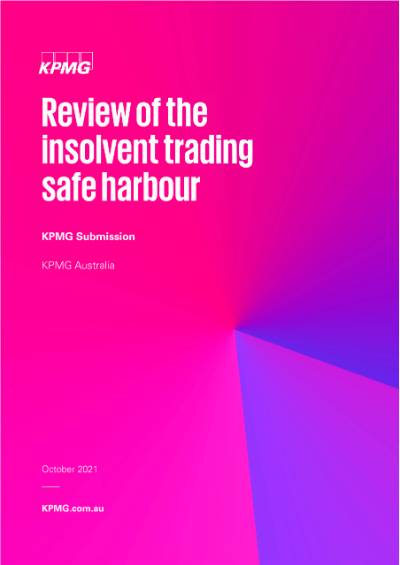As a leading professional services firm, KPMG Australia is committed to meeting the requirements of all our stakeholders – not only the organisations we audit and advise, but also employees, governments, regulators and the wider community. We strive to contribute to the debate that is shaping the Australian economy and welcome the opportunity to provide a response to the insolvent trading ‘Safe Harbour’ review (the review).
The Safe Harbour legislation (section 588GA of the Corporations Act) protects company directors from personal liability for insolvent trading if the company is undertaking a legitimate restructure which is likely to result in a better outcome for the company. KPMG has advised a number of its clients on navigating the requirements of Safe Harbour and has developed a KPMG Framework for Safe Harbour to ensure directors have a better understanding of the steps involved1.
The use of Safe Harbour
While the use of Safe Harbour was expected to increase due to the COVID-19 pandemic, the insolvent trading moratorium enacted in response to the pandemic2 meant that Safe Harbour protection was not required. Additionally, a lack of data makes it difficult to understand how many directors are currently relying upon the Safe Harbour provisions.
We note that the insolvent trading moratorium ended on 1 January 2021 and did not result in any spike in insolvencies or Safe Harbour advice.
Our view is that other government support measures were the key to avoiding large scale insolvencies during the COVID-19 pandemic, and not the insolvent trading moratorium or Safe Harbour provisions. However, the insolvent trading moratorium may have increased awareness of the Safe Harbour provisions for directors.
A solvent restructure is a much-preferred outcome to an insolvent restructuring mechanism such as voluntary administration.
Safe Harbour extends the timeframe for directors to implement a solvent restructure without the risk of being personally liable for debts if the restructure fails. However, Safe Harbour is only available to directors who act quickly when facing into financial decline. Directors who act too late face falling foul of the qualifying criteria for Safe Harbour, meaning that voluntary administration or liquidation may be their only options.
Qualifying for Safe Harbour protection
To successfully qualify for Safe Harbour protection, directors and the company must also meet the various qualifying criteria. The most significant of which is that one or more courses of action needs to be reasonably likely to lead to a better outcome for the company (than the appointment of an administrator or liquidator to the company). The interpretation of ‘reasonably likely’ and ‘better outcome’ can be hard to determine and subject to individual opinion.
Furthermore, the Safe Harbour is only open to directors who are acting honestly and diligently and who have taken appropriate steps to ensure the company has:
- paid entitlements of its employees by the time they fall due
- given returns, notices, statements, applications or other documents as required by taxation laws.
The preconditions above may preclude a significant number of directors from being able to qualify for Safe Harbour due to both employee entitlements (usually superannuation) and tax lodgements rarely being up to date for distressed businesses. However, we believe the preconditions are appropriate, and that improvements need to be made around awareness of the preconditions and director behaviours to allow greater use of the Safe Harbour provisions.
Whilst entering Safe Harbour is a question of adherence to s588GA of the Corporations Act, undertaking a turnaround can be hard to do. For example, the construction of a sufficiently robust and detailed restructuring plan requires expert knowledge and experience, as well as technical proficiency in the application of Australia’s corporate turnaround and insolvency laws. This can act as a barrier to businesses entering Safe Harbour in some circumstances.
KPMG's submission
KPMG’s submission addresses the consultation questions outlined as part of the review and makes several recommendations that could be considered to improve take-up and awareness of Safe Harbour.
We would welcome further discussion with Treasury and the expert panel on this important topic as the review progresses.
KPMG's safe harbour recommendations

Recommendation 1:
The Safe Harbour provisions should be amended to clarify the advice directors are required to obtain to satisfy the requirement that the course of action is reasonably likely to lead to a better outcome which would provide directors with greater certainty, making the provisions more effective.

Recommendation 2:
The Safe Harbour provisions should prescribe who is qualified to provide advice on whether a course of action is reasonably likely to lead to a ‘better outcome’. The Commonwealth should consider limiting the provision of advice to an appropriately qualified and regulated advisor, such as Registered Liquidators or a new designation of Registered Liquidators such as occurred with Small Business Restructuring.

Recommendation 3:
Director awareness of the Safe Harbour provisions (and director duties more generally) must be improved. Consideration should be given to how this information can be provided to company directors, potentially through the introduction of Director Identification Numbers.

Recommendation 4:
The Australian Securities and Investment Commission should start collecting data on Safe Harbour engagements so an assessment can be made on the uptake and usefulness of the Safe Harbour provisions. This could include collection through Registered Liquidator annual returns, statutory reports lodged during the liquidation of companies and annual returns filed by corporations.

Footnotes
- Safe Harbour – Protecting businesses through the COVID-19 crisis (PDF 205KB)
- Section 5885AAA of the Corporations Act





